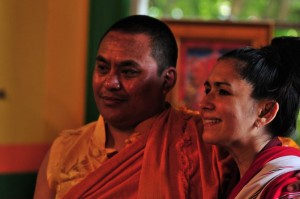Pema Khandro accepted the title of “Tulku Pema Khandro Rinpoche” in order to continue the lineage of one of the few female teachers and yoginis in Tibetan Buddhism’s history.
“I have been given opportunities that women in Tibetan Buddhism have rarely been afforded. After being given heaps of support, kindness, training by my teachers, I also have been given the life circumstances to devote my life full time to the study and teaching of Buddhism.
Then I was given an even greater opportunity of service – to use my teaching activity to continue a lineage of one of the few female Buddhist teachers and yoginis who was remembered in Tibetan history.
So, in the end, I accepted this opportunity as an acknowledgement of the interdependence that female practitioners today have with women’s previous contributions throughout the history of Tibetan Buddhism.”
– Pema Khandro
The recognition of the “tulku” is a traditional way of sustaining lineages in Tibetan Buddhism. Through tulku recognition, the heritage of past Buddhist predecessors is passed on to current leaders who will carry on the tradition. The tulku system is connected with the notion of reincarnation and the belief that the teachings of Tibetan Buddhism can be continued from one life time to the next.
Pema Khandro’s tulku recognition and enthronement was conferred by His Eminence Gyaldak Rinpoche, the Gyaldak Tulku, head of Druk je monastery. “Druk je”
(Tib.འབྲུག་རྗེ་དགོན་པ། ‘brug rje dgon) is the short name for Druk Tashi Dhargey Cholkor Dechenling Monastery in Eastern Tibet (Tib.འབྲུག་བཀྲ་ཤིས་དར་རྗེ་ཆོས་འཁོར་བདེ་ཆེན་གླིང། ‘grug bkra shis dar rje chos ‘khor bde chen gling).

Gyaldak Rinpoche grew up in Tibet and was groomed to remain there as the leader of his monastery. He was recognized as the emanation of Phakmodrupa Dorje Gyalpo, one of the founding fathers of the Kagyu lineage who was a direct disciple of Gampopa. Gampopa in turn was one of the direct disciples of the great Tibetan yogis, Milarepa.
Gyaldak Rinpoche came out of Tibet in 1991 and travelled around the world before recently settling in the Bay area where he has presided over rituals for the local Tibetan community and devotes himself to promoting Buddhism.

When Gyaldak Rinpoche and Pema Khandro first met, they spoke about Buddhism together at length and had an immediate positive connection. He told her the story of Pema Khandro, a yogini from eastern Tibet, and he announced to her and her students that he had recognized her as the reincarnation of that same female teacher who practiced in the early nineteen hundreds in south eastern Tibet.
The previous Pema Khandro had been a teacher and practitioner in the Nyingma and Kagyu lineages who had taught the same teachings that the present-day Pema Khandro had been teaching for over a decade. The previous Pema Khandro and her husband was one of the teachers of Gyaldak Rinpoche’s father. Together with her husband who was a tulku and treasure revealer, she taught both the monks in Gyaldak Rinpoche’s monastery and taught Gyaldak Rinpoche’s father. The previous Pema Khandro also travelled throughout eastern Tibet teaching Chod, Dzogchen and the Six Yogas. Local people regarded her as an emanation of Vajrayogini, and other local people saw her manifest directly as White Tara on several occasions. Thus, she was a revered figure of her local community and is still remembered to this day by an older generation who received her teachings in person. When the cultural revolution took place, the previous Pema Khandro and her family disappeared and the manner of their death is unknown.
On the anniversary of Pema Khandro’s work as a Buddhist teacher, Gyaldak Rinpoche presided over an enthronement ceremony in Berkeley, California, which was attended by fifty of Pema Khandro Rinpoche’s students and friends. Since then, Gyaldak Rinpoche has actively encouraged the current Pema Khandro Rinpoche to continue the teachings of her predecessor and in so doing to spread Buddhism throughout North America and the world.
During the following year after her enthronement, Gyaldak Rinpoche and Pema Khandro Rinpoche taught the Rinchen Trengwa Chod together to her students, bringing a primary practice from the lineage of the first Pema Khandro and home monastery in Eastern Tibet to her North American students. At the end of the retreat when everyone gathered together to chant the practice in English, Gyaldak Rinpoche had tears visibly streaming down his cheeks, overwhelmed with joy to see Americans genuinely engaged in the practice of Buddhadharma, and overjoyed to see the continuation of Pema Khandro’s lineage. The Rinchen Trengwa Chod continues to be practiced by Pema Khandro’s students, alongside other Chod systems.
Gyaldak Rinpoche gave her the title of Tulku Pema Khandro Rinpoche during her enthronement and as per the tradition, in order to honor the interdependence with the history of the lineage, she used the name Pema Khandro when teaching.
When Gyaldak Rinpoche and Pema Khandro met, she had already been concentrated on teaching the very teachings that the previous Pema Khandro was devoted to propagating. Thus, the recognition offers an additional support for the continuation of the work she has been already dedicated to.
Pema Khandro takes a practical and educational approach to her role as a teacher. She has long been an advocate of the recollection of the history of Buddhist yogis in India and Tibet. Thus it was with the motivation to continue the lineage of one of the few remembered female buddhist teachers and yoginis in the history of Tibetan Buddhism, she continues her work in offering the teachings of the Nyingma and Kagyu lineages of Buddhist Yogis.









